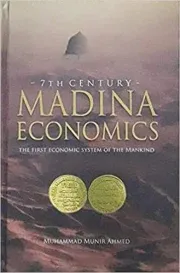7th Century Madina Economics
Title: 7th Century Madina Economics
Author: Muhammad Munir Ahmed
Publisher: Aiwan-e-Ilm-o-Fann, 2020
Islamic Economics - The book is authored by Muhammad Munir Ahmed who has long served in the State Bank of Pakistan. The main thesis of the book is that Islamic economics was the first economic system.
Contemporary institutions which built the foundations of Capitalism after the industrial revolution came much later on. Communism was also a reaction to Capitalism and came later. The rules, norms and institutions of Islamic economics appeared in the state of Medina in the 7th century.
Even though, some scholars view that Islamic economics is not a full-fledged economic system in the sense that it does not have explicit rules for everything in source texts, the author opines that Islamic economic teachings are exhaustive and expendable enough to answer the basic questions which an economic system seeks to answer.
The author highlights that many institutions which are part of Capitalism were initially conceived and operationalized first in the regions under the Muslims rule. For instance, remittances through check and ‘Suftaja’ appeared in Muslim majority regions quite a few centuries ago.
Venture capital investments based on Mudarabah and Musharakah were common in Arab in the 7th century. Trade finance through Salam and Istisna was also allowed and practiced. Waqf based social insurance system was also in vogue. Venture capital in a way was fostering division of labour as well by distinguishing investment entrepreneur from the productive entrepreneur.
Furthermore, Islamic economics laid down laws and norms for transparency and fairness in trade. Certain exploitative and speculative trades were disallowed. Emphasis was put on real economic enterprise by i) disallowing money as a tradable commodity, ii) banning interest and iii) levying a broad based charge on idle wealth and capital.
Prohibition of interest takes away the privilege from the capitalists to have secured increase at a fixed rate in capital by simply loaning it out and without having to undertake any risk and take part in productive enterprise. This principle of prohibition of interest did not undermine economic activity. In fact, it put more focus on trade and productive activities. That is why; very soon, the state of Medina was able to get rid of problems like unemployment, poverty and widened the trade to all parts of the world.
Islamic economics allowed the market mechanism to work, but under certain norms and regulations. Trade is directed towards useful and beneficial commodities and services without the element of exploitation, speculation and interest. This is conducive for increased investment in the real economy.
Islamic moral framework encourages beyond market sharing and distribution of resources. Instead of concentrating wealth as in Capitalism, the Islamic institution of Waqf reduces private concentration of wealth and enhances the scale of common property resources which benefit people at large.
Islamic banking in its conceptual foundations encourages risk-sharing based financing models. On the other hand, instruments like Credit Default Swaps (CDS) encourage excessive leverage by design. Since Islamic finance transactions are asset-based, there is more transparency as compared to the opaque nature of securitized instruments in capitalistic finance.
Therefore, it is no wonder that Islamic financial institutions remained largely unscathed from the Great Financial Crisis of 2007-2010. Nonetheless, splendid financiers and splendid financial products created havoc with the savings of people.
Islamic regulatory and monitoring system is also transparent and consistent. No one is above law. Instead of protecting large scale traders, Islamic norms of trade facilitated the buyers through options of inspection and refund upon finding defect. Such rights protected the trading parties from moral hazard and asymmetric information.
On the other hand, gullible traders were also protected from the monopsonist and oligopsonists who would try to deceive the small farmers to sell their goods cheaply before going to the market. To reduce information asymmetries, it was urged to trade in markets where information collection is easier and it does not result in surplus extraction by one party from the other due to information asymmetries.
Sellers were also freed from having to pay bribes for legitimate services, having to pay interest on money loans and having to pay arbitrary taxes to the Kings without accountability and a say in such matters. Zakat is levied on income and wealth. But, it is not exorbitant to disallow any chance of earning legitimate profits and reinvesting them.
In fact, if wealth is kept invested and spent, it reduces the Zakat liability in many cases. At the same time, it increases investment in the real economy yielding increase in employment through market based exchange of Halal goods and services.
But, in capitalism, large scale corporations sometime become not only too big to fail, but too big to jail or be held accountable. After their reckless operations, many financial institutions had to be bailed from the public money after these corporations had already played havoc with the public money.
Taming selfishness and greed requires a value framework that does not just give sole emphasis on material prosperity and selling lofty dreams. Islamic value framework emphasizes on all-encompassing moral attitude in every sphere of life and to be content with the blessings bestowed by Allah.
The book is easy to read. The author is well informed of both history of commercial and investment banking as well as the contemporary practices and instruments used in the modern financial system. Detailed references are provided to support the facts listed in the book. It is a good contribution in Islamic economics literature. It is written in contemporary style, but with minimal use of jargons to showcase its point for the wider audience.
Source: Islamiceconomicsproject







